Abstract
The specific activation of mast cells in situ causes vigorous local mast-cell mediated angiogenesis (MCMA). The mast cell is a major source of histamine and, as recently reported, specific histamine H1- and H2-membrane receptor antagonists are able individually to significantly suppress MCMA in rats, as assessed using the mesenteric window angiogenesis assay (MWAA). In addition to membrane receptors for histamine, a type of intracellular histamine receptors, designated Hic, has been described. It is now demonstrated that the potent Hic-receptor antagonist DPPE (N,N-diethyl-2-[4-(phenylmethyl)phenoxy]ethanamine HCl), administered parenterally, stimulates MCMA significantly in rats, as quantified by the MWAA. Although the target cell(s) are not known, there are several ways by which their Hic receptors could be activated: uptake of histamine released from mast cells, mobilization from preformed cytoplasmic and nuclear stores, and production of de novo histamine by histidine decarboxylase activity. The fact that the occupancy by histamine of H1- and H2-membrane receptors stimulates MCMA and the occupancy by histamine of Hic inhibits MCMA suggests that endogenous histamine is capable of regulating angiogenesis by a dual mode of action. This is apparently the first report ascribing a dual role of this type in angiogenesis to a single molecule.
Full text
PDF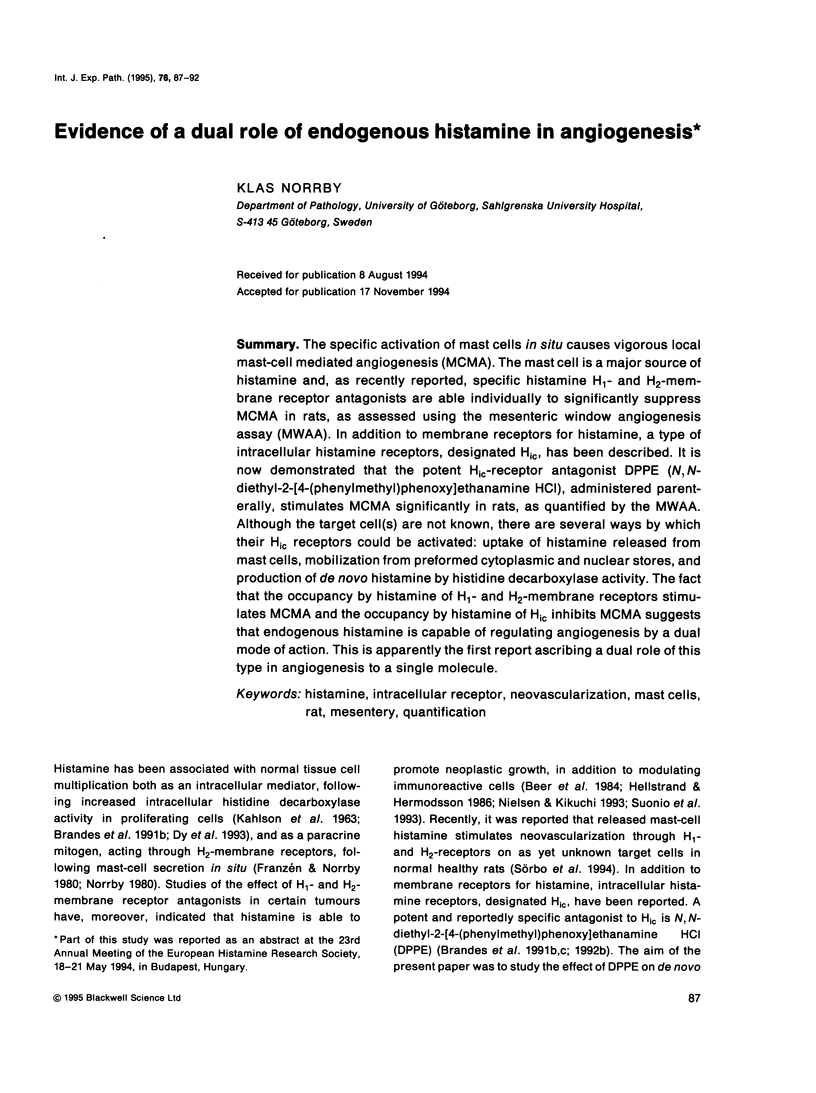
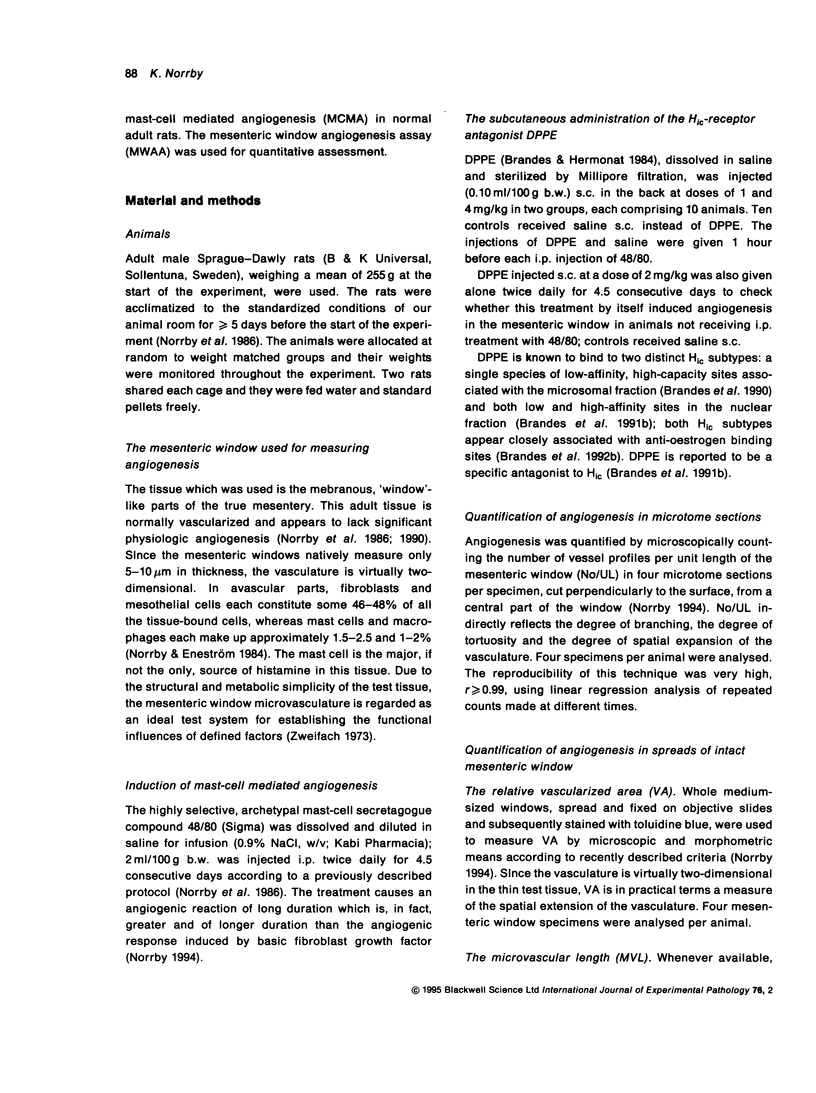
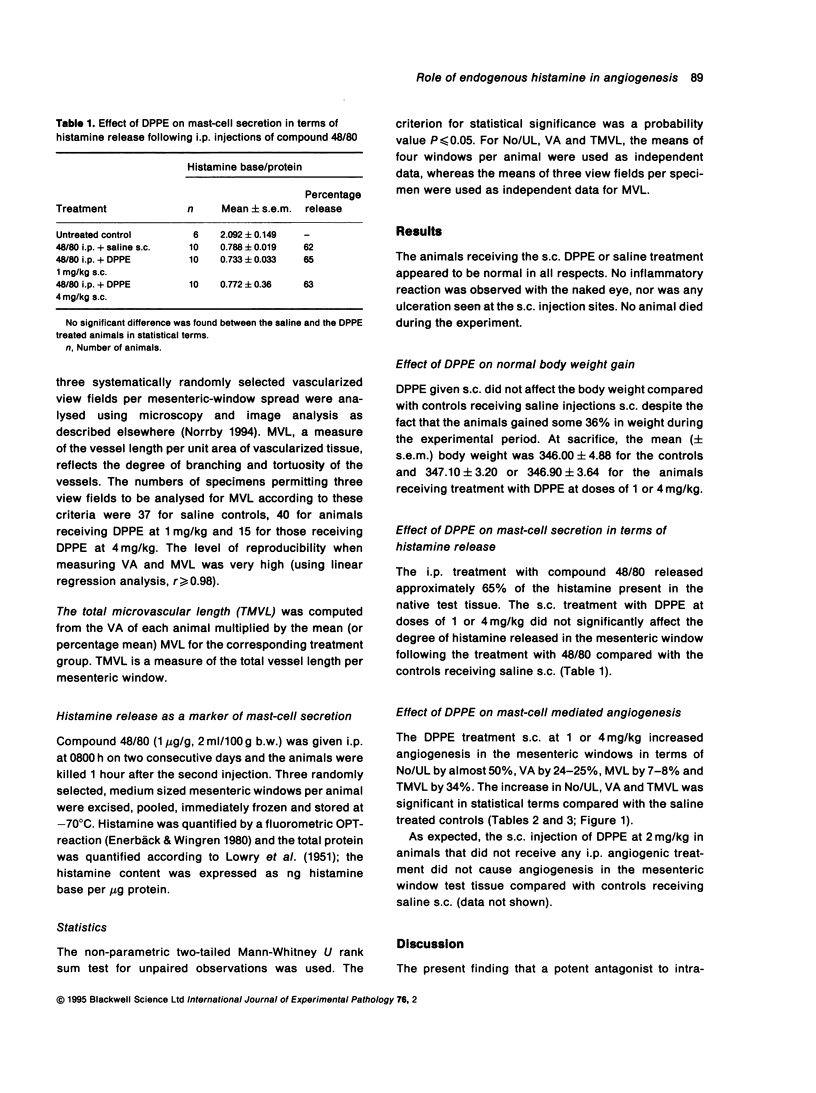
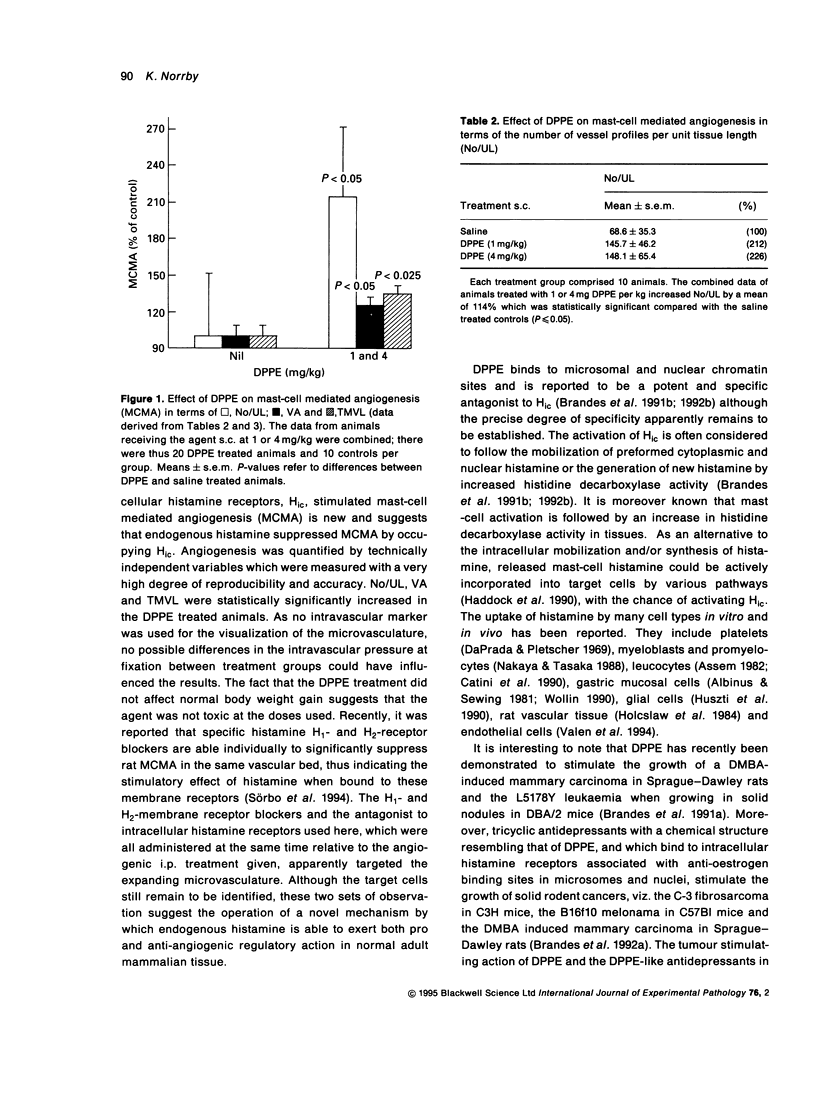
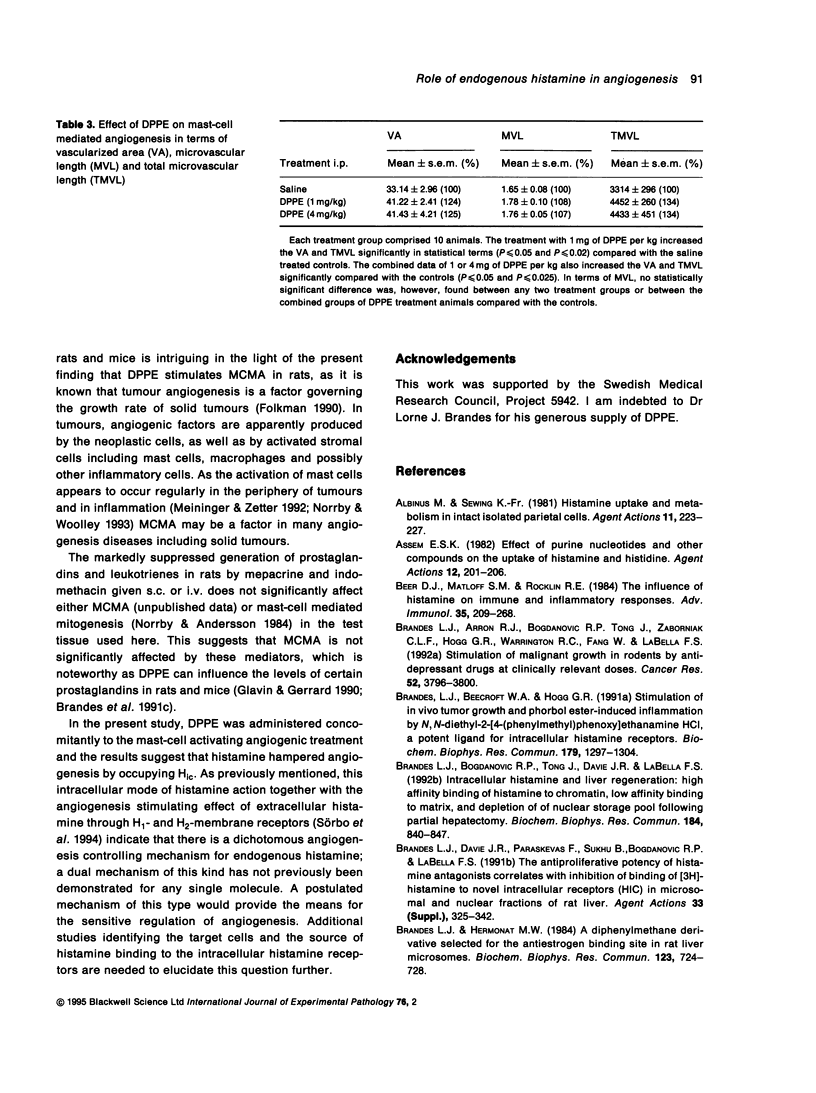
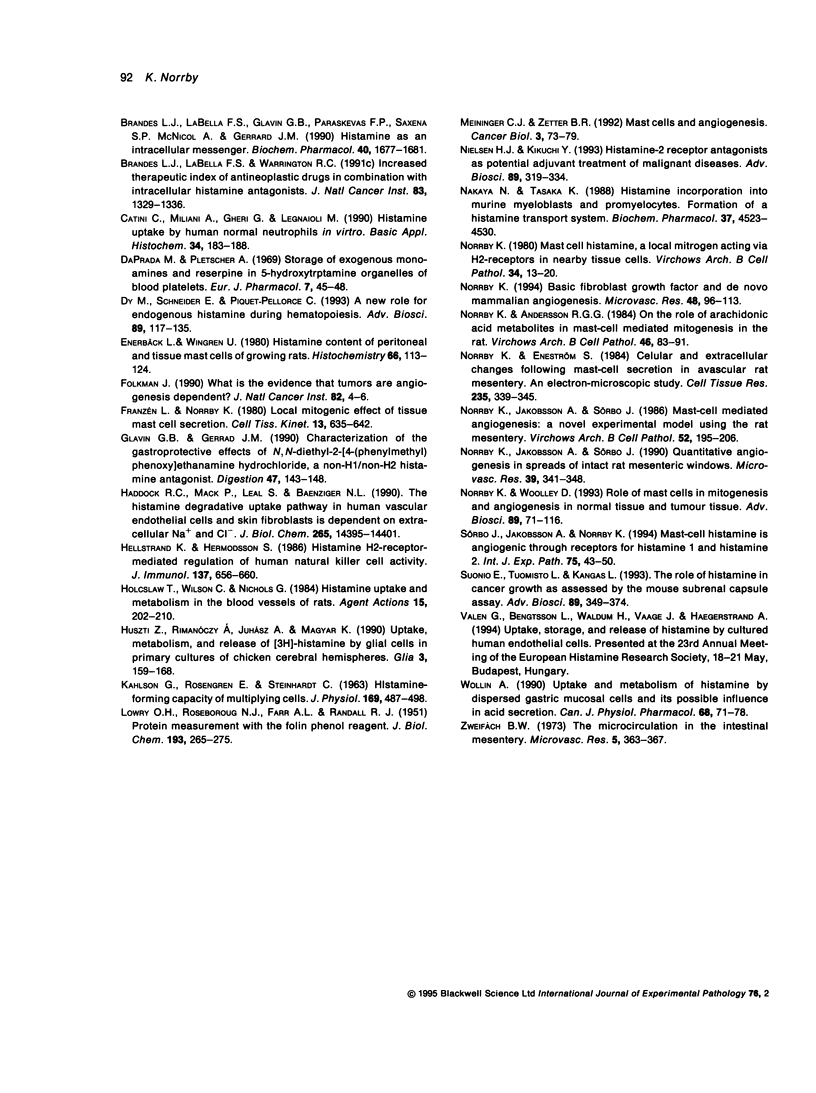
Selected References
These references are in PubMed. This may not be the complete list of references from this article.
- Albinus M., Sewing K. F. Histamine uptake and metabolism in intact isolated parietal cells. Agents Actions. 1981 May;11(3):223–227. doi: 10.1007/BF01967618. [DOI] [PubMed] [Google Scholar]
- Assem E. S. Effect of purine nucleotides and other compounds on the uptake of histamine and histidine. Agents Actions. 1982 Apr;12(1-2):203–206. doi: 10.1007/BF01965146. [DOI] [PubMed] [Google Scholar]
- Beer D. J., Matloff S. M., Rocklin R. E. The influence of histamine on immune and inflammatory responses. Adv Immunol. 1984;35:209–268. doi: 10.1016/s0065-2776(08)60577-5. [DOI] [PubMed] [Google Scholar]
- Brandes L. J., Arron R. J., Bogdanovic R. P., Tong J., Zaborniak C. L., Hogg G. R., Warrington R. C., Fang W., LaBella F. S. Stimulation of malignant growth in rodents by antidepressant drugs at clinically relevant doses. Cancer Res. 1992 Jul 1;52(13):3796–3800. [PubMed] [Google Scholar]
- Brandes L. J., Beecroft W. A., Hogg G. R. Stimulation of in vivo tumor growth and phorbol ester-induced inflammation by N,N-diethyl-2-[4-(phenylmethyl)phenoxy] ethanamine HCl, a potent ligand for intracellular histamine receptors. Biochem Biophys Res Commun. 1991 Sep 30;179(3):1297–1304. doi: 10.1016/0006-291x(91)91714-n. [DOI] [PubMed] [Google Scholar]
- Brandes L. J., Bogdanovic R. P., Tong J., Davie J. R., LaBella F. S. Intracellular histamine and liver regeneration: high affinity binding of histamine to chromatin, low affinity binding to matrix, and depletion of a nuclear storage pool following partial hepatectomy. Biochem Biophys Res Commun. 1992 Apr 30;184(2):840–847. doi: 10.1016/0006-291x(92)90666-9. [DOI] [PubMed] [Google Scholar]
- Brandes L. J., Davie J. R., Paraskevas F., Sukhu B., Bogdanovic R. P., LaBella F. S. The antiproliferative potency of histamine antagonists correlates with inhibition of binding of [3H]-histamine to novel intracellular receptors (HIC) in microsomal and nuclear fractions of rat liver. Agents Actions Suppl. 1991;33:325–342. doi: 10.1007/978-3-0348-7309-3_24. [DOI] [PubMed] [Google Scholar]
- Brandes L. J., Hermonat M. W. A diphenylmethane derivative specific for the antiestrogen binding site found in rat liver microsomes. Biochem Biophys Res Commun. 1984 Sep 17;123(2):724–728. doi: 10.1016/0006-291x(84)90289-4. [DOI] [PubMed] [Google Scholar]
- Brandes L. J., LaBella F. S., Glavin G. B., Paraskevas F., Saxena S. P., McNicol A., Gerrard J. M. Histamine as an intracellular messenger. Biochem Pharmacol. 1990 Oct 15;40(8):1677–1681. doi: 10.1016/0006-2952(90)90341-h. [DOI] [PubMed] [Google Scholar]
- Brandes L. J., LaBella F. S., Warrington R. C. Increased therapeutic index of antineoplastic drugs in combination with intracellular histamine antagonists. J Natl Cancer Inst. 1991 Sep 18;83(18):1329–1336. doi: 10.1093/jnci/83.18.1329. [DOI] [PubMed] [Google Scholar]
- Catini C., Miliani A., Gheri G., Legnaioli M. Histamine uptake by human normal neutrophils in vitro. Basic Appl Histochem. 1990;34(3):183–188. [PubMed] [Google Scholar]
- Enerbäck L., Wingren U. Histamine content of peritoneal and tissue mast cells of growing rats. Histochemistry. 1980;66(2):113–124. doi: 10.1007/BF00494639. [DOI] [PubMed] [Google Scholar]
- Folkman J. What is the evidence that tumors are angiogenesis dependent? J Natl Cancer Inst. 1990 Jan 3;82(1):4–6. doi: 10.1093/jnci/82.1.4. [DOI] [PubMed] [Google Scholar]
- Franzén, Norrby K. Local mitogenic effect of tissue mast cell secretion. Cell Tissue Kinet. 1980 Nov;13(6):635–642. doi: 10.1111/j.1365-2184.1980.tb00502.x. [DOI] [PubMed] [Google Scholar]
- Glavin G. B., Gerrard J. M. Characterization of the gastroprotective effects of N,N-diethyl-2-[4-(phenylmethyl)phenoxy]-ethanamine hydrochloride, a non-H1/non-H2 histamine antagonist. Digestion. 1990;47(3):143–148. doi: 10.1159/000200489. [DOI] [PubMed] [Google Scholar]
- Haddock R. C., Mack P., Leal S., Baenziger N. L. The histamine degradative uptake pathway in human vascular endothelial cells and skin fibroblasts is dependent on extracellular Na+ and Cl-. J Biol Chem. 1990 Aug 25;265(24):14395–14401. [PubMed] [Google Scholar]
- Hellstrand K., Hermodsson S. Histamine H2-receptor-mediated regulation of human natural killer cell activity. J Immunol. 1986 Jul 15;137(2):656–660. [PubMed] [Google Scholar]
- Holcslaw T., Wilson C., Nichols G. Histamine uptake and metabolism in the blood vessels of rats. Agents Actions. 1984 Oct;15(3-4):202–210. doi: 10.1007/BF01972350. [DOI] [PubMed] [Google Scholar]
- Huszti Z., Rimanóczy A., Juhász A., Magyar K. Uptake, metabolism, and release of [3H]-histamine by glial cells in primary cultures of chicken cerebral hemispheres. Glia. 1990;3(3):159–168. doi: 10.1002/glia.440030303. [DOI] [PubMed] [Google Scholar]
- KAHLSON G., ROSENGREN E., STEINHARDT C. HISTAMINE-FORMING CAPACITY OF MULTIPLYING CELLS. J Physiol. 1963 Dec;169:487–498. doi: 10.1113/jphysiol.1963.sp007274. [DOI] [PMC free article] [PubMed] [Google Scholar]
- LOWRY O. H., ROSEBROUGH N. J., FARR A. L., RANDALL R. J. Protein measurement with the Folin phenol reagent. J Biol Chem. 1951 Nov;193(1):265–275. [PubMed] [Google Scholar]
- Meininger C. J., Zetter B. R. Mast cells and angiogenesis. Semin Cancer Biol. 1992 Apr;3(2):73–79. [PubMed] [Google Scholar]
- Nakaya N., Tasaka K. Histamine incorporation into murine myeloblasts and promyelocytes. Formation of a histamine transport system. Biochem Pharmacol. 1988 Dec 1;37(23):4523–4530. doi: 10.1016/0006-2952(88)90668-5. [DOI] [PubMed] [Google Scholar]
- Norrby K., Andersson R. G. On the role of arachidonic acid metabolites in mast-cell mediated mitogenesis in the rat. Virchows Arch B Cell Pathol Incl Mol Pathol. 1984;46(1-2):83–91. doi: 10.1007/BF02890298. [DOI] [PubMed] [Google Scholar]
- Norrby K. Basic fibroblast growth factor and de novo mammalian angiogenesis. Microvasc Res. 1994 Jul;48(1):96–113. doi: 10.1006/mvre.1994.1041. [DOI] [PubMed] [Google Scholar]
- Norrby K., Eneström S. Cellular and extracellular changes following mast-cell secretion in avascular rat mesentery. An electron-microscopic study. Cell Tissue Res. 1984;235(2):339–345. doi: 10.1007/BF00217858. [DOI] [PubMed] [Google Scholar]
- Norrby K., Jakobsson A., Sörbo J. Mast-cell-mediated angiogenesis: a novel experimental model using the rat mesentery. Virchows Arch B Cell Pathol Incl Mol Pathol. 1986;52(3):195–206. doi: 10.1007/BF02889963. [DOI] [PubMed] [Google Scholar]
- Norrby K., Jakobsson A., Sörbo J. Quantitative angiogenesis in spreads of intact rat mesenteric windows. Microvasc Res. 1990 May;39(3):341–348. doi: 10.1016/0026-2862(90)90047-u. [DOI] [PubMed] [Google Scholar]
- Norrby K. Mast cell histamine, a local mitogen acting via H2-receptors in nearby tissue cells. Virchows Arch B Cell Pathol Incl Mol Pathol. 1980;34(1):13–20. doi: 10.1007/BF02892403. [DOI] [PubMed] [Google Scholar]
- Prada M. D., Pletscher A. Storage of exogenous monoamines and reserpine in 5-hydroxytryptamine organelles of blood platelets. Eur J Pharmacol. 1969 Jul;7(1):45–48. doi: 10.1016/0014-2999(69)90161-7. [DOI] [PubMed] [Google Scholar]
- Sörbo J., Jakobsson A., Norrby K. Mast-cell histamine is angiogenic through receptors for histamine1 and histamine2. Int J Exp Pathol. 1994 Feb;75(1):43–50. [PMC free article] [PubMed] [Google Scholar]
- Wollin A. Uptake and methylation of histamine by dispersed gastric mucosal cells and its possible influence on acid secretion. Can J Physiol Pharmacol. 1990 Jan;68(1):71–78. doi: 10.1139/y90-010. [DOI] [PubMed] [Google Scholar]
- Zweifach B. W. The microcirculation in the intestinal mesentery. Microvasc Res. 1973 May;5(3):363–367. doi: 10.1016/0026-2862(73)90051-4. [DOI] [PubMed] [Google Scholar]


